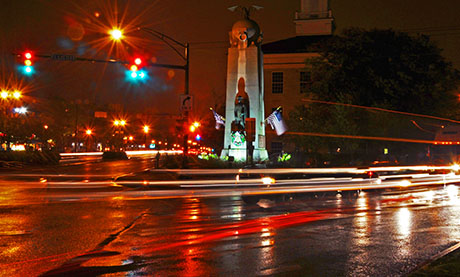
It's not exactly a facelift Gen. Emery Upton will get on the Soldier's Monument at the corner of Ellicott and Main streets in the City of Batavia, but when his bronze sculpture turns 100 next year, you should be able to see it better at night.
Lighting Design Innovations, a Batavia-based company, is planning to install new lighting on the monument next month thanks to $1,500 in donations the company has received for the project.
The county's Ways and Means Committee is recommending the Legislature accept the donation.
Assistant County Manager Matt Landers said company officials describe the current lighting as "flood lights" and their designers will come up with a plan to appropriately light the monument with more modern fixtures to make it more attractive when viewed at night.
LDI, which donated the rotating color lighting for the cupola of the Old Courthouse last year, is also trying to secure $6,500 in donations to pay for colored lighting on two of the pillars of the Old Courthouse.
"They are obviously very passionate about lighting," Landers said.
The offer was well received by the members of the Legislature.
"I think it’s very generous of them," said Marianne Clattenburg, who is chair of Ways and Means.
The Soldier's Monument was first conceived by local citizens in 1882 as a way to pay tribute to those from the area who died in the Civil War. A committee was formed to champion the idea but fundraising, apparently, didn't start until 1903. The first donation came from Albert Knapp.
By the end of the year, the fund reached $1,713.66.
In 1904, voters approved a $10,000 expenditure for the monument. The city agreed to pay another $15,000.
In 1907, there was a move to put Lincoln's bust atop the monument.
The next year, there was an effort to locate the monument in what is now Centennial Park (then called State Park) instead of its present -- and originally proposed -- location.
In 1911, the Genesee County Soldier's Monument Association was formed.
In 1917, the Board of Supervisors viewed a wooden model of the proposed monument and appropriated $10,000 for the project.
The city, at that point, was willing to chip in $5,000.
The granite structure was constructed in Barre, Vt., in 1918. C.A. Worden, a New Yorker, was the designer.
The base was placed in August 1918.
By October 1918, crews were ready to affix the eagle at the top, with a 3-foot, 10-inch tail, and an eight-foot wingspan. The bronze figure of Gen. Emory Upton was paid for by his sister, Sarah Edwards. Another sister, Sara Upton Evans, also made a contribution.
Supervisors accepted monument in January 1919.
As of February 1919, the City had not yet paid for its share of the monument. The county threatened to sue the city and after the county paid the $5,000 due from its contingency fund, the City Council approved paying its $5,000 share In April 1919.
The monument was dedicated Aug. 6, 1919.
Photo: File photo by Howard Owens.
